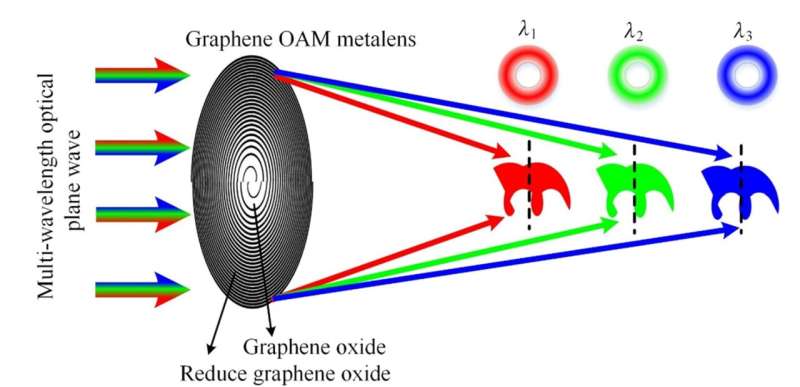This article has been reviewed according to Science X's editorial process and policies. Editors have highlighted the following attributes while ensuring the content's credibility:
fact-checked
proofread
Creating a broadband diffractive graphene orbital angular momentum metalens by laser nanoprinting

Optical beams carrying orbital angular momentum (OAM) attract widespread attention and play an important role in optical data storage, optical communications, quantum information processing, super-resolution imaging, and optical trapping and manipulation. However, the bulky volume and the complex systems of the conventional OAM beam generators limit their applications in integrated and miniaturized optical or photonic devices.
In a study published in the journal Ultrafast Science, Cao and colleagues used ultrafast laser nanoprinting method to fabricate single ultrathin (200nm) graphene metalenses, which integrate OAM generation and high-resolution focusing functions in a broad bandwidth. The broadband graphene OAM matalenses are expected to be widely applied in miniaturized and integrated photonic devices enabled by OAM beams.
New methods based on periodically arranged 2-dimensional nanostructures, namely, metasurfaces, have proven useful in achieving ultrathin and integratable OAM beam generators for high-quality OAM beams. However, traditional broadband metasurface lenses generally require time-consuming processing and complex iterative design methods to achieve accurate wave front control. In comparison, graphene metalenses with simple designs are enabled by a one-step laser nanoprinting.
Graphene materials can simultaneously manipulate the amplitude and phase of a light beam, allowing high flexibility and accuracy in the lens design to achieve desired focal intensity distributions. Recently, Cao et al. realized a new graphene metalens that can focus broadband OAM beams by ultrafast laser nanoprinting.
A method based on the detour phase technique and unique optical properties of graphene oxide was developed to design the graphene OAM metalenses, which can independently control the focusing properties and the topological charge of the OAM at the same time. The broadband ability of the graphene OAM metalens was demonstrated by focusing optical light beams at different wavelengths.
The experimental focusing intensity distributions almost reproduced the theoretical predictions using the Rayleigh–Sommerfeld diffraction theory. The demonstrated ultrathin graphene metalenses provided a simple and cost-effective approach to achieve highly integrated and high-resolution OAM beam focusing. They will find broad applications in optical beam and particle manipulations, data storage, quantum information processing, and mode multiplexing communications in integrated photonic devices.
The resultant graphene metalenses are promising for broad applications in integrated optical and photonic devices using OAM beams. For these applications, a smaller diameter of the doughnut-shaped spot is desired. The methods that improve fabrication, increase the metalens size, or use other 2D materials with higher refractive index contrast are possible to reduce the doughnut-shaped spot size to a certain extent.
However, the minimum diameter of the doughnut-shaped spot of graphene OAM metalens follows the diffraction limit. To further reduce the spot size, the new theory should be proposed, maybe the combination of super oscillation metalens and spiral phase loading is one of the possible methods.
More information: Guiyuan Cao et al, Broadband Diffractive Graphene Orbital Angular Momentum Metalens by Laser Nanoprinting, Ultrafast Science (2023). DOI: 10.34133/ultrafastscience.0018
Provided by Ultrafast Science





















